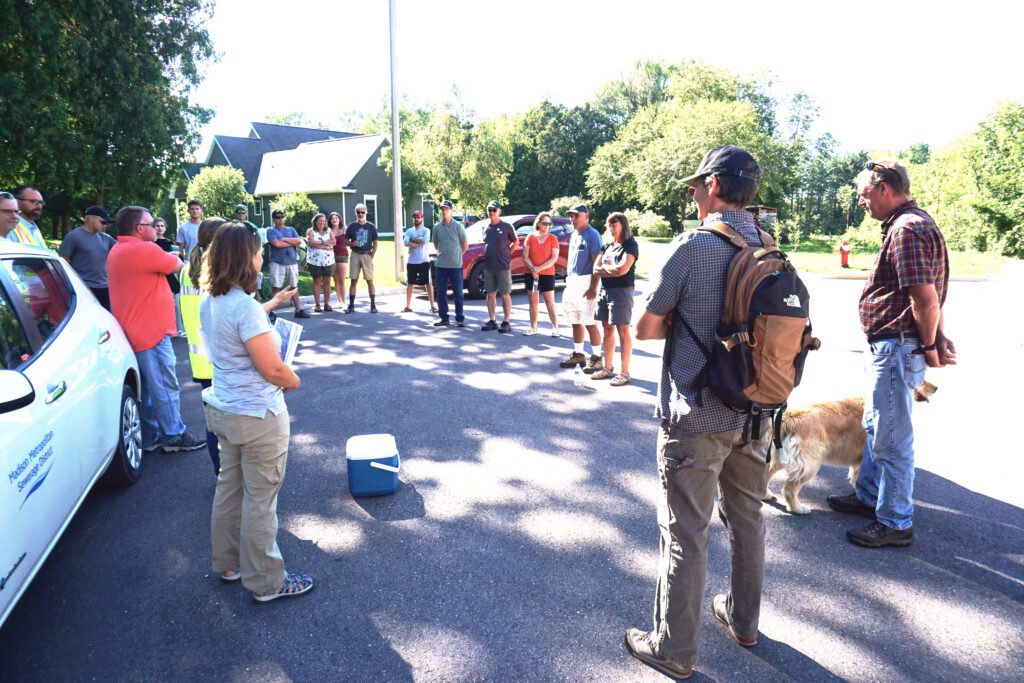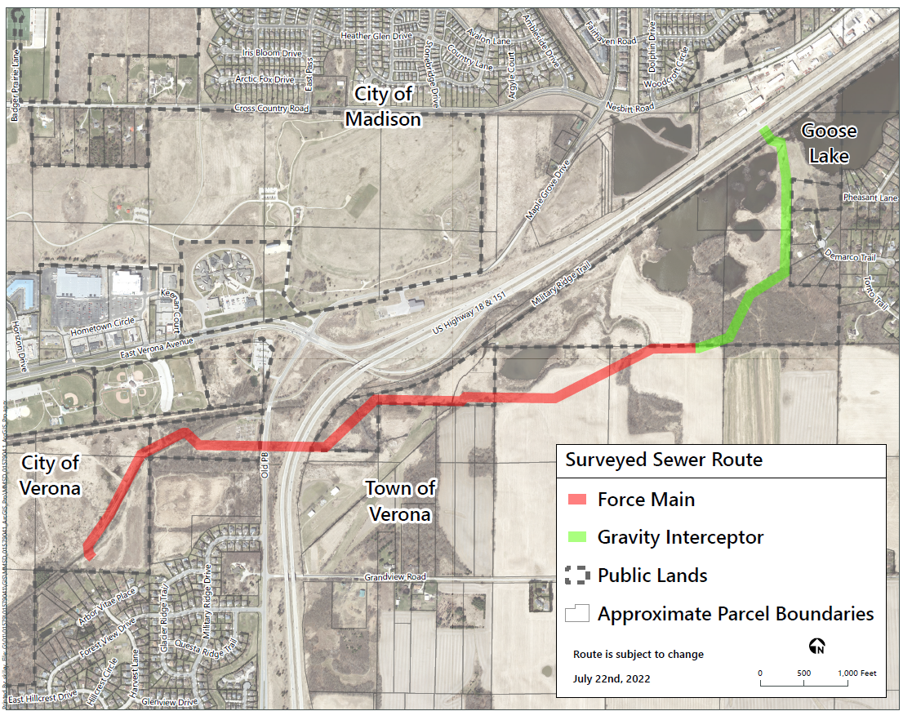The Pumping Station 17 Force Main Relief Phase 2 Project starts construction in winter 23/24 in the City of Verona and the Town of Verona. This project addresses the limited long-term capacity of the existing Pumping Station 17 force main, as the upstream service area has become one of the fastest growing in the state.
Rapid growth requires EngineerEd solutions
The current Pumping Station 17 (PS 17) force main was constructed in 1996. Since then, the service area upstream of PS 17, which includes the City of Verona, Town of Verona, Town of Middleton and City of Madison, has experienced rapid growth requiring additional pumping and conveyance capacity to meet future needs.
Phase 1 of the PS 17 Relief Force Main Project was completed in collaboration with the City of Verona in 2021 as an opportunity to cost-share sewer projects in the same corridor, helping to reduce construction costs by minimizing and/or combining duplicate efforts. Phase 2 extends the District relief force main beyond the Phase 1 corridor and completes the force main. Once completed, the intention is to use the new relief force main while keeping the original force main in service. A relief force main will increase system capacity and also have the added benefit of providing some degree of system redundancy and resiliency with dual force main pumping capabilities from PS 17.
Project Design and public input
As PS 17 will pump the relief force main, this project was designed in tandem with the Pumping Station 17 Firm Capacity Improvements Project. The Pumping Station 17 Firm Capacity Improvements Project will increase capacity by replacing the pumps and select assets at the station. MSA Professional Services, Inc. completed the design of both projects.
Route selection plays a key part in how the force main will operate for years to come. The existing force main has a significant change in elevation to convey wastewater. As a result, this requires a high amount of pumping operating power. During route selection, the total change in elevation and pumping operating power for each relief force main route was examined. In addition, a variety of other factors were considered. Input was sought from the community on the route selection at a public involvement meeting and through a follow-up survey.

It became apparent during the Phase 2 route selection process there would be challenges to every route. The selected route was chosen because it:
- Provides an opportunity for consolidation of utilities and serves as a regional wastewater solution for the Town of Verona, City of Verona, and City of Fitchburg;
- Will use gravity for a portion and potentially avoid a City of Verona pumping station; comparatively uses approximately 30% less operational energy than other possible relief routes, under design conditions; and,
- Strategically terminates to minimize future District work for the Nine Springs Valley Interceptor Capacity Improvements – Phase 1 Project.
The project used the Institute for Sustainable Infrastructure’s ENVISION process as a guideline, which helped the project team select the route and explore mitigation strategies. In the selected route, environmental impacts were present and mitigated to the extent possible. The route avoids high-value ecological trees, such as oak and hickory, and mapped archaeological sites.
The project team coordinated with the Wisconsin Department of Natural Resources and adjusted the schedule, route, and methods to minimize disturbance (including wetlands) where possible. Additionally, the project completed an ecological field survey specifically to inventory threatened, endangered, special concern, and invasive species.
Adjacent residents, Ice Age Trail volunteers, and others were highly engaged throughout the design process and were interested in what the project would look like post-construction. A series of on-site meetings were held with interested parties to listen and to best address their concerns. A public tree inventory viewer was developed to communicate about trees anticipated to remain or be removed within the construction corridor. In addition, the restoration plans were shared with the public for comment.
Through the ENVISION process, a sustainable ideas list was generated and later led to potential corridor improvements to be explored. These potential improvements were discussed with entities and the public, and a public survey was conducted. There was a large public interest in weighing in on these ideas, with the survey receiving 109 responses. The results of this survey were used to inform the design of the City of Verona paved path, Ice Age Trail realignment, and final selected improvements. The final corridor improvements are illustrated in Figure 1.
installation PLAN
The project includes installing approximately 1.5 miles of 24-inch relief force main to an ultimate high point, followed by approximately 0.6 miles of an interceptor sewer before connecting to the District’s Nine Springs Valley Interceptor. The sewer installation will necessitate construction in wetlands and includes four creek crossings of the Lower Badger Mill Creek. Additionally, approximately 600 lineal feet of trenchless installation at Old PB and U.S. Highway 18/151 is anticipated.

The project will install new force main and interceptor sewer manholes, including replacing an existing Town of Verona 8-inch sewer which will contain a District monitoring manhole. The project also includes the extension of the City of Verona Lower Badger Mill Creek Path, which will consist of a prefabricated steel truss pedestrian bridge with cast-in-place abutments, an asphalt path, and the removal of an existing bridge.
Other items necessary to facilitate construction of the project include erosion control, dewatering, select tree removals, traffic control, temporary stormwater management, site restoration, and others. In order to construct these sewer improvements, portions of the Military Ridge State Trail, Ice Age Trail, and local trails will need to be detoured or temporarily realigned.
Collaboration on improvements
District projects occasionally present opportunities with municipalities for partnership, especially on construction. Phase 1 of the Pumping Station 17 Force Main Relief project, completed in 2021, had a successful partnership with the City of Verona. Phase 2 of the project presented the same opportunity to partner with municipalities to combine adjacent projects under a single contract. The District completed agreements with both the City of Verona and the Town of Verona independently to reduce construction costs by minimizing and/or combining duplicate efforts in the area, and to utilize the same contractor while on site. As part of the City of Verona work, the contractor will expand a local multi-modal asphalt path connection and as part of the Town of Verona work, the contractor will abandon a local sewer vulnerable to increasing water levels in the adjacent Goose Lake.
Among the selected improvements spurred by the project, the District and Dane County have committed to restoring portions of the project corridor to native vegetative species. A portion of the route even garnered the nickname “honeysuckle forest” by project team members as the invasive species are almost impenetrable. Areas of native restoration will be turned over to Dane County and others to maintain in perpetuity after the 1-year project warranty.
Next step – construction
The project anticipated starting construction the week of Nov. 13, 2023. Minger Construction Co., Inc., is the awarded contractor with a bid of approximately $9.4 million. The schedule will consist of various stages for sewer construction to minimize impacts to wetland areas during the growing season. Construction is anticipated to be complete in the summer of 2025. As any engineer will share, the sequence and schedule are subject to change and weather dependent.
You can read more about the project, find updates, documents and more on the project page: Pumping Station 17 Force Main Relief, Phase 2.
Written by Rachel Feil.






